Titan
Vulcans
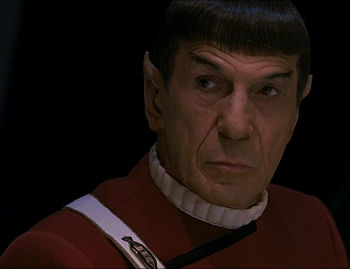
Spock, Vulcan male (ST-06)
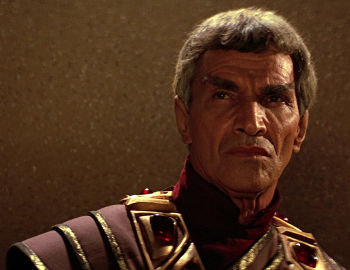
Sarek, Vulcan male (ST-03)
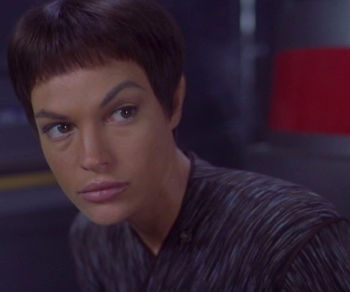
T’Pol, Vulcan female (ENT-22)
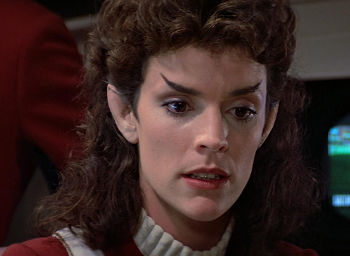
Saavik, Vulcan female (ST-03)
Species originating on Vulcan,[3] Vulcans were dedicated to a philosophy of emotional suppression in favor of total logic.[2]
References
- 1. “The Cage.” Star Trek, Episode 00. Television. 1965 (Unaired).
- 2. “Mudd’s Women.” Star Trek, Episode 03. Television. 13 October 1966.
- 3. “Amok Time.” Star Trek, Episode 34. Television. 15 September 1967.
- 4. “Journey to Babel.” Star Trek, Episode 44. Television. 17 November 1967.
- 5. “The Savage Curtain.” Star Trek, Episode 77. Television. 7 March 1969.
- 6. Star Trek II: The Wrath of Khan. Film. 4 June 1982.
- 7. “Broken Bow.” Star Trek: Enterprise, Episodes 01-02. Television. 26 September 2001.
Starbases

Watchtower-class starbase (TOS-53)
The Federation asserted its sovereignty in space space through a series of starbases, which could be located on a planet’s surface or on a space station, or a combination of both. This network of starbases provided a wide range of services; starbases could act as supply posts, recreation facilities, scientific outposts, trade hubs, and administrative centers. While all starbases provided each of these services, many were noted for their superiority in one or two specific areas.[1]
Starbases
| Number | Type | Location | Quadrant |
|---|---|---|---|
| 1 | Surface | Berengaria VII | Alpha |
| 2 | Station | Between Beta Auriga, Camus II; Near Betreka Nebula, Planet Q | Alpha |
| 4 | Station | Lyris Corridor | Unk. |
| 6 | Station | Past Aldebaran | Unk. |
| 7 | Station | Unk. | Unk. |
| 8 | Station | Near Pollux II | Unk. |
| 9 | K-series station | Near Pyris VII | Unk. |
| 10 | Station | Near Gamma Hydra IV; near Bassen Rift, Romulan Neutral Zone | Beta |
| 11 | Surface | Planet Yko | Alpha |
| 12 | Station | Gamma 400 System, near Deneva | Beta |
| 13 | Station | Pharos | Unk. |
| 14 | K-series station | Unk. | Unk. |
| 20 | Unk. | Unk. | Unk. |
| 23 | Unk. | Onias Sector, near Triangle border | Beta |
| 24 | R-1 class station | Klingon border; near Khitomer, Hromi Cluster | Beta |
| 27 | Surface | Near Klingon border | Beta |
| 29 | Unk. | Unk. | Unk. |
| 36 | Unk. | Along Klingon border; near Krios, Ty’gokor | Beta |
| 39-Sierra | Station | Along Romulan border; Kaleb sector | Beta |
| 40 | Unk. | Unk. | Unk. |
| 41 | Unk. | Unk. | Unk. |
| 44 | Station | Near Mariotian Sector | Unk. |
| 45 | Unk. | Algol II | Unk. |
| 47 (a.k.a. “Vanguard”) | Watchtower class station | Taurus Reach | Beta |
| 56 | Unk. | Unk. | Unk. |
| 63 | Unk. | Unk. | Unk. |
| 67 | Unk. | Unk. | Unk. |
| 68 | Unk. | Unk. | Unk. |
| 73 | Unk. | Unk. | Unk. |
| 74 | Spacedock station | Tarsas III | Unk. |
| 82 | Unk. | Unk. | Unk. |
| 83 | Unk. | Unk. | Unk. |
| 84 | Spacedock station | Unk. | Unk. |
| 87 | Unk. | Near Boraal II | Unk. |
| 92 | Spacedock station | Unk. | Unk. |
| 97 | Surface | Unk. | Unk. |
| 99 | R-1 class & Spacedock stations | Unk. | Unk. |
| 103 | Unk. | Near Minos | Unk. |
| 105 | Unk. | Near Klingon Border | Beta |
| 108 | Unk. | Unk. | Unk. |
| 113 | Unk. | Unk. | Unk. |
| 117 | Unk. | Along Klingon border, near Krios | Beta |
| 118 | Unk. | Unk. | Unk. |
| 123 | Unk. | Near Klingon & Romulan borders; near Iconia, Iccobar | Beta |
| 124 | Unk. | Unk. | Unk. |
| 129 | Unk. | Near Alpha Majoris | Alpha |
| 133 | Spacedock station | Unk. | Unk. |
| 137 | Unk. | Unk. | Unk. |
| 152 | Unk. | Near Canopus System | Beta |
| 153 | Unk. | Unk. | Unk. |
| 157 | Unk. | Near Acamar System, Triangle border | Beta |
| 173 | R-1 class station | Sector 23, near Romulan border | Beta |
| 179 | Surface | Unk. | Unk. |
| 180 | Spacedock station | Near Tholian Assembly | Alpha |
| 185 | Unk. | Approx. 2 years, 7 months from System J-25 at warp 9 | Beta |
| 195 | Surface | Nilicia Sector | Unk. |
| 200 | Unk. | Unk. | Unk. |
| 201 | Unk. | Unk. | Unk. |
| 211 | Station | Near Sheva System, along Cardassian border; Dorvan Sector | Alpha |
| 212 | Unk. | Along Klingon border; near Relay Station 47, Veridian System | Beta |
| 214 | Unk. | Near Penthara IV | Alpha |
| 215 | Spacedock station | Unk. | Unk. |
| 218 | Unk. | Unk. | Unk. |
| 219 | Unk. | Unk. | Unk. |
| 220 | Unk. | Near Tyken’s Rift | Unk. |
| 227 | Unk. | Unk. | Unk. |
| 231 | Unk. | Unk. | Unk. |
| 234 | Surface | Triangle border | Beta |
| 247 | Unk. | Near Romulan Neutral Zone | Beta |
| 257 | Station | Bajor Sector | Alpha |
| 260 | Unk. | Near Mar Oscura Nebula | Unk. |
| 295 | Unk. | Unk. | Unk. |
| 301 | Unk. | Near Satarran space | Unk. |
| 310 | Unk. | Near Alpha Trianguli; Dorvan Sector | Alpha |
| 313 | Unk. | Near Guernica System | Unk. |
| 315 | Unk. | BeTau Sector | Alpha |
| 324 | Unk. | Unk. | Unk. |
| 328 | Unk. | Near Barson II | Unk. |
| 336 | Unk. | Unk. | Unk. |
| 343 | Unk. | Near Paulson Nebula, Triangle border | Beta |
| 375 | R-1 class station | Kalandra sector | Alpha |
| 401 | Unk. | Unk. | Unk. |
| 416 | Unk. | Near Ogus II | Unk. |
| 440 | Unk. | Unk. | Unk. |
| 495 | Unk. | Near Marijne VII | Unk. |
| 514 | Unk. | Near Izar | Alpha |
| 515 | Surface | Scylla Sector, near Epsilon IX Sector | Unk. |
| 621 | Unk. | Near Tzenkethi Coalition border | Alpha |
| 718 | Unk. | Near Romulan Border; Sector Z-6 | Beta |
| Farspace Starbase Earhart | Unk. | Unk. | Unk. |
| G-6 | Unk. | Near Betazed | Alpha |
| Lya III | Unk. | Near Angosia III | Unk. |
| Montgomery | Surface | Unk. | Unk. |
| Xendi Starbase 9 | Unk. | Unk. | Alpha |
References
- 1. “Core Game Book.” Star Trek Role Playing Game, Book 4500. Game. 1999. Last Unicorn Games.
Starfleet Command

Starfleet Command (ST-04)
The operating authority for Starfleet,[1] Starfleet Command was based out of San Francisco on Earth,[2] though command facilities were also located on major worlds and starbases throughout Federation space.[3] The Chief of Starfleet Operations oversaw a staff of admirals, each responsible for a specific region or division.[4]
References
- 1. “Court Martial.” Star Trek, Episode 15. Television. 2 February 1967.
- 2. Star Trek IV: The Voyage Home. Film. 26 November 1986.
- 3. The Star Trek Encyclopedia. Book. 1997 (rev. ed.). Pocket Books.
- 4. “Core Game Book.” Star Trek: The Next Generation Role Playing Game, Book 25000. Game. August 1998. Last Unicorn Games.
Vulcan
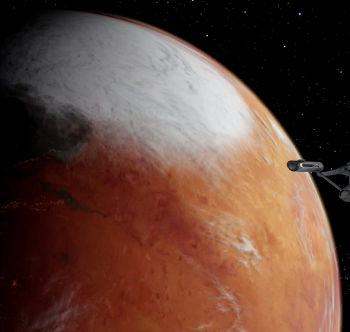
Vulcan (TOS-34)
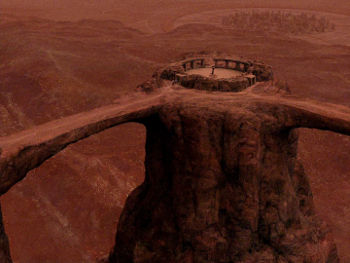
Vulcan surface (TOS-34)
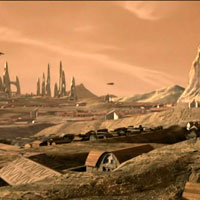
Vulcan surface (ENT-79)
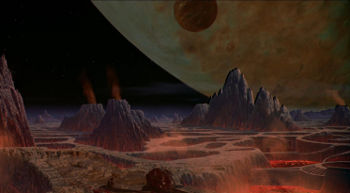
Vulcan Surface (ST-01)

Vulcan Surface (ST-01)
Vulcan, a Class-M world,[2, 4] was the second planet in the 40 Eridani trinary system, orbiting 40 Eridani A.[4] Although Vulcan had no moon,[1] the planet shared an orbit with its sister world, T’Khut.[3]
› Continue reading
Sol System
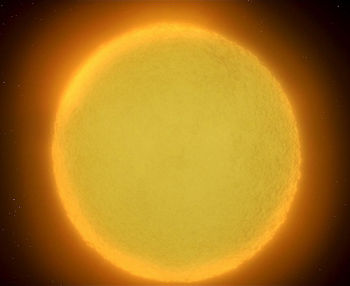
Sol (ST-04)
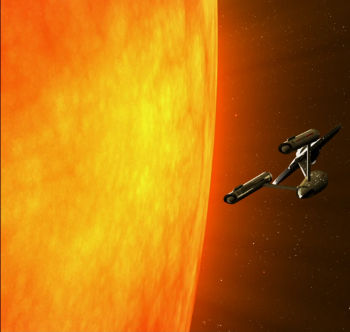
Sol (TOS-21)
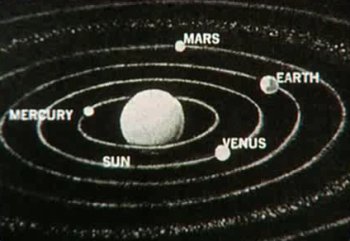
Sol System (TOS-00)
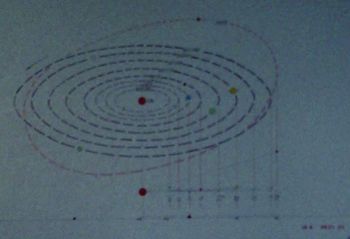
Sol System (TOS-37)
Star system located in Sector 001, in the Alpha Quadrant. The parent star, Sol, was Type-G and was orbited by eight planets (though Pluto frequently switched between being considered a planet and a planetoid),[2] including Earth, and was commonly known as the Sun. The Talosians viewed an image of the Sol System and many images of Earth’s history while accessing the U.S.S. Enterprise NCC-1701‘s computer in 2254.[1]
Planets
References
- 1. “The Cage.” Star Trek, Episode 0. Television. 1965 (Unaired).
- 2. “Before Dishonor.” Star Trek: The Next Generation. Novel (Unnumbered). November 2007.
Luna
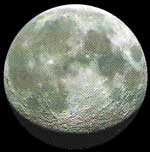
Luna (STSC)
Luna, commonly known simply as “the Moon,” was a Class-D world orbiting Earth.[4] By the late 24th century, more than 50 million people lived on the Moon.[3] The Talosians viewed several images about Earth’s Moon and programs to study and explore it while accessing the U.S.S. Enterprise NCC-1701‘s computer in 2254.[1] The Copernicus Ship Yards were located in orbit, with office facilities on the surface; the U.S.S. Hathaway NCC-2593 was built there.[2] Other points of interest on the Moon included Tranquility Base, where Apollo 11 landed in July 1969; as well as Lake Armstrong and New Berlin.[3] See also: Apollo program, Armstrong, Neil, Kennedy, John F., Lunar probe, Ranger probe.
References
Elaysia
A world with extremely low surface gravity compared to most Class-M planets. Its native people, though capable of spaceflight, rarely left their homeworld, and those that did were forced to use personal antigrav units to adapt to the gravity conditions shared by most other humanoid species. One such Elaysian was Melora Pazlar, the first of her people to attend Starfleet Academy and become an officer. The garlanic tree was a native plant.[1]
References
Earth
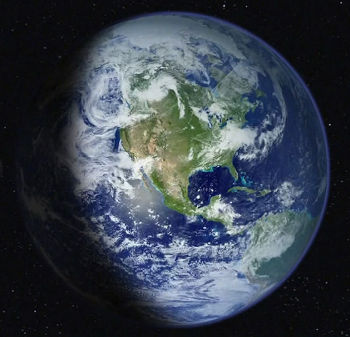
Earth (TOS-21)

Earth (ENT-78)
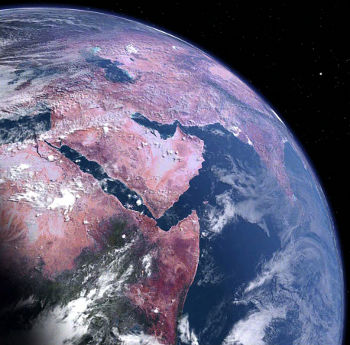
Earth (TOS-55)
Class-M. Earth is the third planet in the Sol System[1] in Sector 001[7] and homeworld of Humans. In 2254, the Talosians viewed an image of the Sol System and many images of Earth’s history while accessing the U.S.S. Enterprise NCC-1701‘s computer.[1] Earth became one of the founding members of the United Federation of Planets in 2161,[15] following the Romulan War,[6] and served as that body’s capital.[5] Starfleet Command and Starfleet Academy were based in San Francisco,[2, 3] while the offices of the Federation President[9] and the Federation Council chamber were located in Paris.[22] The planet hosted several advanced orbital habitats,[2] Starfleet spacedocks,[4] and satellite networks, including Federation communications networks.[12]
› Continue reading
Deneva
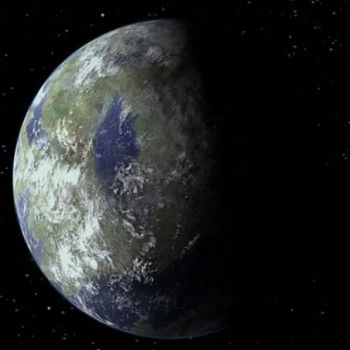
Deneva (TOS-29)
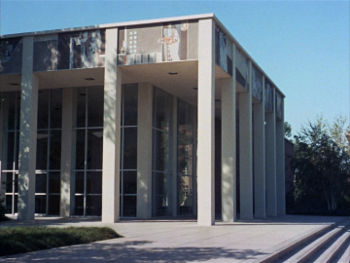
Deneva surface (TOS-29)
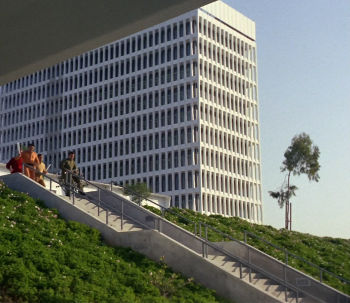
Deneva surface (TOS-29)
M-class planet considered by many to be one of the most beautiful in the galaxy, which was colonized by humans in the 22nd century,[5] and later became a Federation world.[8] It was used as a freighting line base in the region.[1] Deneva, the third planet orbiting Kappa Fornacis in the Beta Quadrant,[4] served as a key supply station for many Earth cargo ships, including the E.C.S. Horizon,[5] for at least two centuries.[2] Freighters would make regular trips from Deneva carrying supplies to the nearby asteroid belt for the miners stationed there, and bringing cargo out. Montgomery Scott was an engineering advisor on a couple of those freighter runs.[1]
› Continue reading
Planet, Class-M

Earth (ENT-78)

Vulcan (TOS-34)
Terrestrial. Age ranged from 3-10 billion years. Diameter was 10,000 to 15,000 km. Typically located in the Ecosphere of a planetary system. Surface water was abundant; if water or ice covered more than 80% of the surface, the planet was considered Class O or Class P. Atmosphere was primarily primarily nitrogen, oxygen, and trace elements. Contained extensive vegitation and animal life.[8] Capable of supporting carbon-based, humanoid life.[1]
The designation apparently stemmed from the Vulcan word “Minshara,” which was used to designate planets capable of supporting life.[7] Class-M planets could vary widely in color, cloud cover, and overall appearance. Most Class-M planets were characterized by a relatively thin, tectonically active crust floating on a molten rock mantle, which in turn surrounded a liquid metal outer core and a solid inner core composed of metal crystals.
› Continue reading
Categories
- Animated Series (60)
- Articles (28)
- Books (447)
- Cast & Crew (79)
- Comics (22)
- DS9 (328)
- Early Voyages (125)
- Education (5)
- Enterprise (373)
- Excelsior (36)
- Food (19)
- Games (223)
- Klingon (70)
- Library (1,543)
- Logs (593)
- Lost Era (55)
- Medicine (18)
- Merrimac (1)
- Mirror (35)
- Miscellaneous (13)
- New Frontier (54)
- Next Generation (635)
- Original Series (681)
- Personnel (436)
- Places (369)
- Politics (12)
- Recreation (10)
- SCE (41)
- Science (1)
- Shatnerverse (9)
- Ships (455)
- Site Updates (98)
- Starfleet Academy (86)
- Stargazer (42)
- STO (61)
- Technology (45)
- Titan (59)
- To Boldly Go (1)
- TV/Film (214)
- Uncategorized (4)
- Vanguard (76)
- Voyager (236)
- Weapons (27)
- Xenology (54)